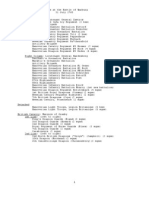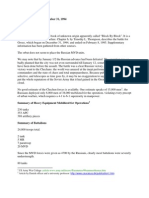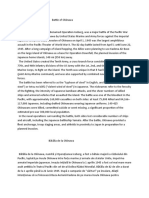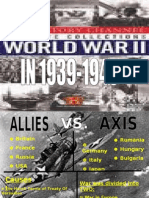0 ratings0% found this document useful (0 votes)
96 viewsThe Schlieffen Plan
The Schlieffen Plan
Uploaded by
Arin RahmanThe Schlieffen Plan was a German military strategy for a quick victory against France in the event of a two-front war. It called for invading France through the neutral Low Countries and rapidly encircling Paris with a force of 90% of the German army. The remaining 10% would defend against Russia. However, the plan failed due to Belgium resisting longer than expected, Britain joining the war, and Russia mobilizing faster than predicted, forcing Germany to halt its advance on Paris short of its goal.
Copyright:
© All Rights Reserved
Available Formats
Download as PPTX, PDF, TXT or read online from Scribd
The Schlieffen Plan
The Schlieffen Plan
Uploaded by
Arin Rahman0 ratings0% found this document useful (0 votes)
96 views12 pagesThe Schlieffen Plan was a German military strategy for a quick victory against France in the event of a two-front war. It called for invading France through the neutral Low Countries and rapidly encircling Paris with a force of 90% of the German army. The remaining 10% would defend against Russia. However, the plan failed due to Belgium resisting longer than expected, Britain joining the war, and Russia mobilizing faster than predicted, forcing Germany to halt its advance on Paris short of its goal.
Original Title
The Schlieffen Plan (1)
Copyright
© © All Rights Reserved
Available Formats
PPTX, PDF, TXT or read online from Scribd
Share this document
Did you find this document useful?
Is this content inappropriate?
The Schlieffen Plan was a German military strategy for a quick victory against France in the event of a two-front war. It called for invading France through the neutral Low Countries and rapidly encircling Paris with a force of 90% of the German army. The remaining 10% would defend against Russia. However, the plan failed due to Belgium resisting longer than expected, Britain joining the war, and Russia mobilizing faster than predicted, forcing Germany to halt its advance on Paris short of its goal.
Copyright:
© All Rights Reserved
Available Formats
Download as PPTX, PDF, TXT or read online from Scribd
Download as pptx, pdf, or txt
0 ratings0% found this document useful (0 votes)
96 views12 pagesThe Schlieffen Plan
The Schlieffen Plan
Uploaded by
Arin RahmanThe Schlieffen Plan was a German military strategy for a quick victory against France in the event of a two-front war. It called for invading France through the neutral Low Countries and rapidly encircling Paris with a force of 90% of the German army. The remaining 10% would defend against Russia. However, the plan failed due to Belgium resisting longer than expected, Britain joining the war, and Russia mobilizing faster than predicted, forcing Germany to halt its advance on Paris short of its goal.
Copyright:
© All Rights Reserved
Available Formats
Download as PPTX, PDF, TXT or read online from Scribd
Download as pptx, pdf, or txt
You are on page 1of 12
THE SCHLIEFFEN
PLAN
The First World War1914-
1918
KEY WORDS
British Expeditionary Force
‘A scrap of Paper’
Retreat
Deadlock
‘contemptibly little army’
OVERVIEW
In1914, Germany believed
war with Russia was extremely
likely. If war broke out,
Germany assumed France
would also attack as she was
both an ally of Russia and keen
for revenge for her defeat in
the Franco-Prussian war.
If this happened, Germany would face a war
on two fronts. Germany wanted to avoid this
at all costs.
Germany planned to defeat France rapidly
and then turn to the eastern front for a
major offensive on Russia. This was the basis
for the Schlieffen Plan.
DIAGRAM
BACKGROUND
The Germany Army Chief of Staff, Alfred von
Schlieffen was asked to plan a way of
preventing a war on two fronts. His initial
plan was produced late in 1905. He believed
that it was a priority to defeat France
quickly, forcing them to surrender before
Russia had a chance to mobilize her armed
forces.
VON SCHLIEFFEN
In full knowledge of French defences,
Schlieffen proposed attacking France through
Holland, Belgium and Luxembourg – the
Benelux countries. Schlieffen planned to use
90% of German military forces to deliver a
knock out blow to France. The remaining
10% would defend the eastern border of
Germany against Russian attack.
VON MOLKTE
Von Molkte replaced Von Schlieffen in 1906,
and made some alterations to the plan. His
version avoided invading Holland, instead
concentrating attack through Belgium.
According to Von Molke, the Belgium army
would be unable to resist a powerful German
military, and German forces would rapidly
enter France.
VON MOLKTE
ASSUMPTIONS
Russia would take at least 6 weeks to
mobilize.
France would be easily defeated in 6
weeks.
Belgium would not resist any German
attack.
Britain would remain neutral.
THE REALITY
On 2nd August 1914, the German army invaded
Luxembourg and Belgium according to the Schlieffen
Plan.
The Germans were held up by the Belgium army,
backed up by the BEF (British Expeditionary Force)
which arrived extremely quickly.
Russia mobilised in just 10 days and Germany was
forced to withdraw troops from the Schlieffen Plan to
defend her eastern border.
Germany did not take the chance to take Paris,
instead decided to attack east of the capital. They
were met by French at the battle of the Marne (5-11
Sept) which halted the German advance.
You might also like
- Znotes // Igcse Series: Summarised Notes ON THE First World WAR (Depth Study)Document12 pagesZnotes // Igcse Series: Summarised Notes ON THE First World WAR (Depth Study)Aman Singh100% (4)
- WMA Quick Ref SheetDocument3 pagesWMA Quick Ref Sheetmacieyr4101No ratings yet
- The - Schlieffen - Plan - (Resource)Document14 pagesThe - Schlieffen - Plan - (Resource)safwanmahsinNo ratings yet
- Schlieffen WarDocument15 pagesSchlieffen WarJames GleesonNo ratings yet
- IGCSE History World War One SampleDocument2 pagesIGCSE History World War One SampleMariam AhmedNo ratings yet
- Student Copy of ww1 Revision GuideDocument127 pagesStudent Copy of ww1 Revision GuideAyhan NaimanNo ratings yet
- Why Did The Schlieffen Plan FailDocument1 pageWhy Did The Schlieffen Plan FailRóbert TothNo ratings yet
- ww1 Overview BookletDocument18 pagesww1 Overview Bookletapi-3623189850% (1)
- Schlieffen PlanDocument6 pagesSchlieffen PlanYasmeen Copty100% (1)
- The First Battle of the Marne 1914: The French ‘miracle’ halts the GermansFrom EverandThe First Battle of the Marne 1914: The French ‘miracle’ halts the GermansNo ratings yet
- How Did The War Start?Document17 pagesHow Did The War Start?Derrick RobertsNo ratings yet
- HIST103 6.2.1 FWWPlanning FINALDocument5 pagesHIST103 6.2.1 FWWPlanning FINALJohnNo ratings yet
- Schlieffen PlanDocument2 pagesSchlieffen Plannighthawke1No ratings yet
- A) The Western Front B) The Eastern Front C) The Balkan Front D) The Turkish Front E) The Austro-Italian FrontDocument8 pagesA) The Western Front B) The Eastern Front C) The Balkan Front D) The Turkish Front E) The Austro-Italian FronttinevimboNo ratings yet
- The War On The Western FrontDocument23 pagesThe War On The Western FrontDanielSunjicNo ratings yet
- Battles of World War OneDocument191 pagesBattles of World War OneAmyNo ratings yet
- European History/World War I: The Road To WarDocument9 pagesEuropean History/World War I: The Road To WarARPITNo ratings yet
- WW1 Revision BookletDocument6 pagesWW1 Revision BookletMuhammad AayanNo ratings yet
- Schlieffen Plan - NoteDocument9 pagesSchlieffen Plan - NoteJonathan JayakrishnanNo ratings yet
- The Clever Teens' Guide Bumper Edition: The Clever Teens’ GuidesFrom EverandThe Clever Teens' Guide Bumper Edition: The Clever Teens’ GuidesNo ratings yet
- WW1 PDFDocument15 pagesWW1 PDFRoseline lawrenceNo ratings yet
- Caie Igcse History 0470 Depth Studies A The First World War 191418 v2Document10 pagesCaie Igcse History 0470 Depth Studies A The First World War 191418 v2lavanyagolebuissnessNo ratings yet
- Germany and ww1Document2 pagesGermany and ww1api-246113958No ratings yet
- Notes 2-28-17Document2 pagesNotes 2-28-17api-331466756No ratings yet
- The Clever Teens' Guide to World War One (The Clever Teens’ Guides)From EverandThe Clever Teens' Guide to World War One (The Clever Teens’ Guides)No ratings yet
- First Ypres 1914: The graveyard of the Old ContemptiblesFrom EverandFirst Ypres 1914: The graveyard of the Old ContemptiblesRating: 4 out of 5 stars4/5 (11)
- The Clever Teens' Guide to World War One: The Clever Teens’ Guides, #5From EverandThe Clever Teens' Guide to World War One: The Clever Teens’ Guides, #5No ratings yet
- The Schlieffen PlanDocument5 pagesThe Schlieffen Plankrishnamehta2611No ratings yet
- SchlieffenplanDocument1 pageSchlieffenplanapi-264916183No ratings yet
- Blitzkrieg 02 - France, Holland and Belgium 1940-1941Document98 pagesBlitzkrieg 02 - France, Holland and Belgium 1940-1941jdrm5100% (11)
- Blitzkrieg 02 France Holland and Belgium 1940-1941Document98 pagesBlitzkrieg 02 France Holland and Belgium 1940-1941Douglas Grigg100% (6)
- Schlieffen Plan Worksheet 2023Document3 pagesSchlieffen Plan Worksheet 2023Yes LolNo ratings yet
- Schlieffen Plan Worksheet 2023Document3 pagesSchlieffen Plan Worksheet 2023Yes LolNo ratings yet
- War Presentation Template 1Document17 pagesWar Presentation Template 1thefalseboy23No ratings yet
- Caie Igcse History 0470 Depth Studies ww1 1914 18 v1Document10 pagesCaie Igcse History 0470 Depth Studies ww1 1914 18 v1rferNo ratings yet
- World War 1Document65 pagesWorld War 1ashleymatheka9No ratings yet
- WW1 World WarDocument19 pagesWW1 World WarMohammad Asif FarooqiNo ratings yet
- Grudic World War I - PracticesDocument70 pagesGrudic World War I - PracticesHaydy GadallaNo ratings yet
- 3.causes of WWIDocument6 pages3.causes of WWIshanaayaa30No ratings yet
- The Great War: Field Marshal von HindenburgFrom EverandThe Great War: Field Marshal von HindenburgRating: 3.5 out of 5 stars3.5/5 (2)
- World War I Exam NotesDocument18 pagesWorld War I Exam NotesifodifodfNo ratings yet
- History InfographDocument2 pagesHistory Infographneal.fernandesNo ratings yet
- The Western Front: Schlieffen Plan Alfred Von SchlieffenDocument4 pagesThe Western Front: Schlieffen Plan Alfred Von SchlieffenAnna SanchezNo ratings yet
- France - Britain - RussiaDocument2 pagesFrance - Britain - Russiazoegarciam1No ratings yet
- 1940 in The WestDocument7 pages1940 in The Westapi-316940023No ratings yet
- World War I BattlesDocument11 pagesWorld War I Battlesyv6f8hgpf9No ratings yet
- MillennialDocument15 pagesMillennialmsimangarvNo ratings yet
- General Albert Von Schlieffen Chief of The German General StaffDocument4 pagesGeneral Albert Von Schlieffen Chief of The German General StaffFemi AmooNo ratings yet
- Ww1 Revision Sheets CombinedDocument8 pagesWw1 Revision Sheets CombinedAwura KwayowaaNo ratings yet
- Rommel - The Rise of The Desert FoxDocument4 pagesRommel - The Rise of The Desert FoxClaus Jørgen PetersenNo ratings yet
- Year 10 2ND Term History NoteDocument21 pagesYear 10 2ND Term History NoteadewalezoeyNo ratings yet
- The Defeat of GermanyDocument1 pageThe Defeat of GermanynkathaanjuriNo ratings yet
- Wwi Season3 140704020508 Phpapp02Document26 pagesWwi Season3 140704020508 Phpapp02Anonymous HumanNo ratings yet
- The Allied Powers vs. The Central Powers of World War I: History 6th Grade | Children's Military BooksFrom EverandThe Allied Powers vs. The Central Powers of World War I: History 6th Grade | Children's Military BooksNo ratings yet
- Causes of World War 1 AssessmentDocument3 pagesCauses of World War 1 AssessmentAnonymous R7BvO3No ratings yet
- What Human Conditions Are Caused by MicroorganismsDocument8 pagesWhat Human Conditions Are Caused by MicroorganismsArin RahmanNo ratings yet
- Material Changes (Unit 9.1-9.3)Document17 pagesMaterial Changes (Unit 9.1-9.3)Arin RahmanNo ratings yet
- Presentation ON "Serial Data Transmission AND Synchronous Data Transfer"Document12 pagesPresentation ON "Serial Data Transmission AND Synchronous Data Transfer"Arin RahmanNo ratings yet
- Object Oriented Design and Programming II: Professor Dr. Mohammad Abu YousufDocument41 pagesObject Oriented Design and Programming II: Professor Dr. Mohammad Abu YousufArin RahmanNo ratings yet
- Bataan Death MarchDocument1 pageBataan Death MarchHasz RonquilloNo ratings yet
- Marie-Eugène DebeneyDocument11 pagesMarie-Eugène DebeneyFrancis BrownNo ratings yet
- Battle of Warburg 31 July 1760Document2 pagesBattle of Warburg 31 July 1760Mark GriffinNo ratings yet
- Hube'S Pocket: Asl Scenario GDocument1 pageHube'S Pocket: Asl Scenario GJuan Diego Conde EguiletaNo ratings yet
- Regiment KalbermattenDocument4 pagesRegiment KalbermattenGiovanni Cerino-BadoneNo ratings yet
- Chapter 2 Canada and The First World War VocabularyDocument4 pagesChapter 2 Canada and The First World War VocabularyMalak El KerdanyNo ratings yet
- Coming of Age EssayDocument3 pagesComing of Age EssayAlexNo ratings yet
- Avalon Hill Cross of Iron Scenario 3Document1 pageAvalon Hill Cross of Iron Scenario 3GianfrancoNo ratings yet
- World War II: MR - Cleggett Luis Torres Mod 3Document4 pagesWorld War II: MR - Cleggett Luis Torres Mod 3Luis TorresNo ratings yet
- Cardinal Numbers: ST TH ST THDocument2 pagesCardinal Numbers: ST TH ST THАня РяполоваNo ratings yet
- Chandrahasam - Trailer Ebook PDFDocument11 pagesChandrahasam - Trailer Ebook PDFSeshadri Shankaran0% (2)
- The Battle of The AtlanticDocument9 pagesThe Battle of The Atlanticapi-445856493No ratings yet
- Prices Raid Into Missouri-Rev1Document32 pagesPrices Raid Into Missouri-Rev1Paul SappNo ratings yet
- Label Piala Intercom PlayGroupDocument2 pagesLabel Piala Intercom PlayGroupLia WidhyaNo ratings yet
- World War I ProjectDocument14 pagesWorld War I ProjectJim_Shaw0% (1)
- The Charge of The Light Brigade PPDocument39 pagesThe Charge of The Light Brigade PPashykynNo ratings yet
- Intro To War Horse - Lesson 1Document23 pagesIntro To War Horse - Lesson 1Mrs_PPNo ratings yet
- Grozny 1994Document4 pagesGrozny 1994DhukoooOhhh:)No ratings yet
- Battle of OkinawaDocument2 pagesBattle of OkinawaFlorentin NistorNo ratings yet
- R20N Russian Army of The Caucasus 1803-1813 Azerbaijan (7234637)Document2 pagesR20N Russian Army of The Caucasus 1803-1813 Azerbaijan (7234637)Regulator0No ratings yet
- Terrain Effects Chart - Introduction: Wagon SDocument9 pagesTerrain Effects Chart - Introduction: Wagon SNosmo KingNo ratings yet
- Cinco de MayoDocument2 pagesCinco de MayolettyNo ratings yet
- (DO2019) Dash For The WireDocument1 page(DO2019) Dash For The WireRaúlNo ratings yet
- Rifle and KepiDocument1 pageRifle and KepiJoe BogieNo ratings yet
- Second World War (1939-1945)Document8 pagesSecond World War (1939-1945)Sekolah Menengah Rimba67% (3)
- Arc of Osiric Battle PlanDocument8 pagesArc of Osiric Battle Planmeko naichiNo ratings yet
- IELTS Test Dates 2015Document1 pageIELTS Test Dates 2015Abdel Hafid LahrecheNo ratings yet
- Naval Warfare of World War IDocument4 pagesNaval Warfare of World War Iankush birlaNo ratings yet
- How The Italian Invasion of Abyssinia Affected The League ReputationDocument10 pagesHow The Italian Invasion of Abyssinia Affected The League Reputationapi-25886465No ratings yet





























































































